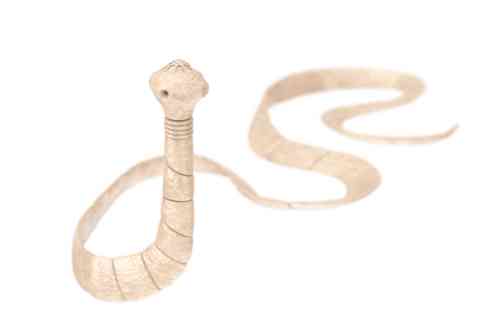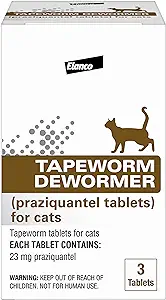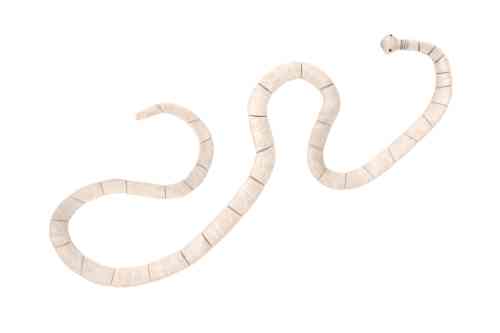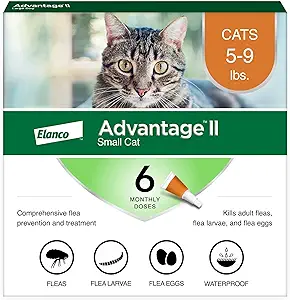A tapeworm in your cat
White moving strings from your cat’s anus
A tapeworm in your cat. Disgusting. Would rather not have one, right? In this article we explain everything about tapeworms in cats. We discuss what it is and what symptoms you can see if your cat is infected. And we tell you what consequences it can have. But most importantly: what you can do about it. And also how you can prevent tapeworms in your cat.
What is a tapeworm?
There are different types of worms that can live in your cat’s intestines. In addition to roundworms and hookworms, a cat can also get a tapeworm in its intestines. Where a roundworm and hookworm are nicely round in diameter, a tapeworm is flattened. In addition, a tapeworm consists of all kinds of pieces, the proglottids. These pieces contain the eggs of the tapeworm. The tapeworm releases these pieces from its body to spread the eggs in your cat’s living environment. The special thing, however, is that these pieces, the proglottids, can move on their own. They then crawl out of your cat’s anus independently.
Can a cat get infected with a tapeworm?
Not only is it possible that a cat can get a tapeworm. In fact, they have them quite often. According to a large study in France from 2022, 3% of French cats have a tapeworm in their intestines. This is not expected to be much different in the rest of the world. In other words, about 1 in 33 cats has gotten a tapeworm. And possibly their owner too. Because your cat can infect you with one too! We will tell you more about this later in this article.
Which tapeworm species occur in the United States in cats?
The most common tapeworms in cats in the United States are the tapeworms called Dipylidium caninum and Taenia taeniaeformis. Very occasionally Echinococcus multilocularis also occurs. You can immediately forget these names. We are going to talk about the flea tapeworm, which is the Dipylidium caninum. The raw meat tapeworm, that is the Taenia taeniaeformis. And the fox tapeworm, Echinococcus multilocularis.
How does a cat get a tapeworm in its intestines?
Your cat gets the flea tapeworm from any fleas that live on it. The tapeworm eggs are in the body of the flea. When your cat washes himself, he may ingest such a flea. The flea is dissolved during digestion, but the tapeworm eggs are very resistant to gastric acid. They therefore remain alive. These eggs then hatch in the small intestine and form the tapeworm.
Cats get the raw meat tapeworm by eating rats and mice in particular. The original eggs of the tapeworm are ingested by the rats or mice, after which the eggs hatch and form so-called cysts in the liver and other organs of the mice or rats. If your cat eats this infected rat or mouse, it will ingest those cysts. These cysts are also very resistant to gastric acid. Once in your cat’s small intestine, they will form an adult tapeworm that can in turn form eggs and contaminate your cat’s environment.
They can get infected with the fox tapeworm by coming into contact with the feces of infected animals, which does not necessarily have to be the fox. But they can also get the fox tapeworm if they eat a rodent infected with fox tapeworm.
What symptoms can you see in a cat with a tapeworm?
In general, your cat has little trouble with one tapeworm that is present in its intestines. The more tapeworms they have, the more symptoms will be visible. But there are some symptoms you might notice:
- White little strings that crawl out of your cat’s anus on their own. These are the proglottids.
- These strings dry up into a kind of rice grains.You can find these where your cat likes to sleep.
- Itching on his anus due to the wriggling of the tapeworm pieces
- Mild diarrhea
- Very occasionally a tapeworm is regurgitated in its entirety.
- Very occasionally you can encounter the tapeworm in its entirety in your cat’s feces
- A dull coat may develop due to reduced nutrient availability.
- Losing weight due to being able to absorb less food
- Decreased appetite due to intestinal inflammation
However, with the fox tapeworm the complaints can be much more serious. Bladders filled with fluid and eggs form in your cat’s body. This can occur in organs, resulting in failure of that organ. The symptoms can therefore be very diverse. However, this tapeworm is very rare in cats in the US.
How do you find out that your cat is infected with a tapeworm?
You can have a stool test performed by your veterinarian. Or you can use the test below. This will then examine your cat’s feces for all kinds of worms, including tapeworms. But actually it is not really necessary to make a diagnosis at all. The test costs about 10 times as much as giving your cat a deworming treatment (this we write about later in this article). In most cases, a cat hardly has any complaints from the tapeworm and it is the owner who notices that white strings are crawling out of their cat’s anus.
Consequences of a tapeworm in your cat
The consequences of a tapeworm in cats can be described as very mild. Most cats show no complaints unless there gut is completely filled in tapeworms.
Some cats have very mild gastrointestinal complaints such as nausea or diarrhea. They may also want to eat less due to it. However, in rare cases, a tapeworm infection can lead to an intestinal blockage. You can recognize this by a very sick cat with very severe belly pain. This can be fatal for a cat, so if you see this in your cat, you should immediately go to your (emergency) veterinarian.
If a cat has multiple tapeworms in its intestines, the intestines may work less. In addition, the tapeworms absorb the nutrients that are actually intended for your cat. As a result, your cat will lose weight and develop a less shiny coat.
Your cat may also suffer from itching on his buttocks. After all, the proglottids will crawl out of his anus themselves and can move over his fur. This can cause your cat to feel itchy, causing your cat to lick its anus a lot or rub its buttocks on the ground.
Can a tapeworm in a cat go away on its own?
If your cat only has 1 tapeworm, it can die in your cat’s intestines, after which it will be expelled in the feces. Your cat will then be rid of his tapeworm. In most cases, however, there are multiple tapeworms in your cat’s intestines. The chance that he is completely free of tapeworms after he has pooped one out is small. The tapeworm usually lives for several months, so your cat will suffer from this tapeworm for a very long time. That is why it is better to treat a cat that you know has a tapeworm with a tapeworm treatment.
What is the treatment if your cat has a tapeworm?
Fortunately, there are many options for this. The cheapest solution is to give your cat a deworming treatment that also kills tapeworms. So if you buy one, check if it says that it kills tapeworms. You can read it in the deworming package leaflet. There are tablets, pipettes for the neck or pastes. Below we give you an example of a suitable very good deworming treatment against tapeworms in a cat. They also work against all other types of worms that cats may have in their intestines.
How often should I deworm my cat?
If you think your cat has a tapeworm, 1 treatment with one of the above products is sufficient. For tapeworm infections it is not necessary to repeat the treatment after a few weeks. But you do need to repeat the treatment if there was an infection with roundworms and hookworms. In that case, the treatment must be repeated after 3 weeks because the young stages of the worms do not always die from deworming. But this problem does not occur with a tapeworm.
The ESCCAP (European Scientific Counsel Companian Animal Parasites) advises you to deworm your cat once every 3 months to keep the consequences of worm infestation as minimal as possible. This applies to all types of intestinal worms that can affect your cat.
What is the life cycle of a tapeworm in your cat?
Flea tapeworm
An adult tapeworm resides in a cat’s intestine. There it produces eggs in the proglottids. These are then released from the tapeworm. They crawl out through your cat’s anus and contaminate the environment. These eggs are eaten by flea larvae. As the flea larva matures, the tapeworm egg also grows. It then forms inside the flea into a cysticercoid larva. This is a very resistant tapeworm larva. If your cat licks itself while washing, it can ingest this flea, which contains the resistant tapeworm larva. The flea is dissolved in the gastric acid, but the resistant larva can withstand this. Ultimately, it ends up in your cat’s intestine. There the larva can grow into an adult tapeworm, which in turn will produce proglottids with eggs.
Raw meat tapeworm
With this tapeworm the procedure is approximately similar. The adult tapeworm is alive in the intestine of a cat. This produces proglottids with eggs. They come out with the feces. This feces can spread over grasses and plants or in water. And so do the eggs of the tapeworm. A mouse or rat eats the plants or drinks from contaminated water and thus becomes infected with the eggs. In rodents, the eggs develop into cysts. These are also resistant variants of a young tapeworm. These resistant cysts mainly form in rodent organs. As soon as the cat catches and eats this rat or mouse, the resistant cysts enter the stomach. They are also not destroyed by stomach acid, but end up in your cat’s intestines. There, these tapeworms continue to grow into adult tapeworms that can reproduce again.
Fox tapeworm
An adult tapeworm is usually found in the intestine of a fox, but a dog or cat is also possible. It forms eggs in the intestine. This is also done in a proglottid, but with this tapeworm the proglottid remains attached to the body. The eggs therefore hatch from the proglottid while it is still in the animal’s body. These eggs will come out with the feces and spread in nature. The eggs are ingested by small rodents such as mice. This is where resistant larvae of the tapeworm emerge again. Particularly in the liver, but also in other organs. These resistant forms are also called hydatid cysts. They are able to grow and become quite large, causing the organ to no longer function properly.
The final host, usually the fox, then eats these mice with the cysts, after which the tapeworm can mature. However, this tapeworm is quite small and hardly causes any problems for your cat. But it is also possible that your cat is the intermediate host and not the mouse. Hydatid cysts may then develop in your cat’s organs. And these cause more damage to your cat than the adult tapeworm. Fortunately, this does not often occur in cats.
Is having a tapeworm dangerous for your cat?
In principle, most tapeworms are certainly not life-threatening for your cat. But exceptions are possible. As we already wrote, it is possible that your cat will develop a problem in his intestines. We talked about an intestinal blockage, but actually it is mainly that a piece of intestine can get stuck in another piece of intestine. This is rare, but possible. As a result, your cat may die if surgical intervention is not performed.
In addition, there is the risk of developing hydatid cysts from the fox tapeworm. That chance is also small since cats do not often eat plants and berries, but it can sometimes happen. Depending on where the cyst is located, it can cause more or less misery.
Tapeworm in a kitten
Kittens generally do not catch a rat or mouse very often. They also spend relatively little time outdoors when they are still very young. However, they are sensitive to fleas. The risk of flea-tapeworm will therefore be greatest for them. It is generally accepted that from the moment an egg is ingested by a flea to the moment the tapeworm becomes an adult, it takes approximately 3 weeks. Very young kittens cannot yet be treated with very strong deworming treatments that also kill tapeworms. But the chance of developing problems as a result of a tapeworm is very small in kittens. From the age of 6 weeks, the kittens can be dewormed with a product against tapeworms, provided they weigh at least 500 grams.
Is a tapeworm contagious to humans?
Infections with the raw meat tapeworm are rare in humans. However, the flea tapeworm can cause infections in humans. Adult humans are not likely to ingest an infected flea, so the chance is quite small. But small children are not concerned about fleas, so they can become infected. You may also see small itchy white strings crawling out of their anus and they may have some abdominal pain or mild diarrhea.
The most dangerous of all, however, is the fox tapeworm. If your cat (or dog) has the adult fox tapeworm in its intestines, the eggs will end up in your home. In that case, it is possible that you ingest those eggs. They can then also form hydatid cysts in your body. The organ in which they do this will suffer damage. Although this is a very dangerous tapeworm, we humans rarely suffer from it. There is a greater chance that you, for example, pick berries in the forest and become infected that way than that you become infected through your cat (or dog).
Can you prevent a tapeworm infection in your cat?
The only way to prevent tapeworms in your cat is to ensure that he never gets fleas and cannot catch rats or mice. So make sure that your cat is given a strong flea treatment every month. And is he a very good hunter? Then put a collar with a bell on him. This significantly reduces the chance of catching rodents. And with that, of course, the chance of getting a tapeworm. And if he does get a tapeworm, treat it by giving him a deworming every 3 months. Good luck!









